
Detail of Donald Horsburgh's living-room, August 2012.
Donald HORSBURGH in his living room in Pittenweem.
He got is first job in the harbour when he was 14 stacking wooden fish boxes for £1 a week. He then served as a whaler in the Southern Venturer Expedition in 1948-49 (Antarctic) when he was 18 years old. He got his skipper certificate in 1962 but he is better known as Pittenweem Harbour Master, a position he held for 17 years until he retired aged 65.
Home detail: painting of Great Yarmouth harbour by his brother, More Horsburgh, fisherman and self-taught painter.
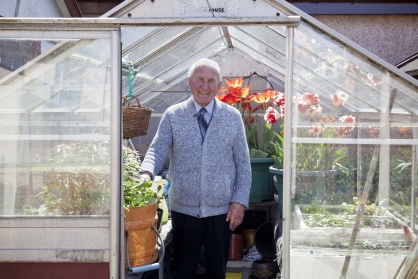
Wullie Wood, retired fisherman, in his green house in May 2013.
Wullie WOOD in his greenhouse in Pittenweem.
Son of a fisherman, he became a fisherman in 1944 when he was 14 years old and he retired when he was 58 years old. He mainly fished in the Firth of Forth at a time when more fish were landed in Pittenweem than in Peterhead; he experimented with all types of fishing: first line fishing, then seine netting, then he went fishing in Dogger Bank with the great lines, then pair trawling over hard ground from 25 to 200 miles away from Pittenweem harbour in the North Sea.
Home detail: drawing of his mother (Maggie Wood) baiting the lines.
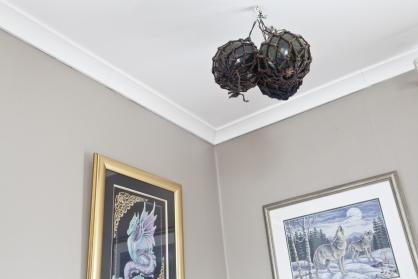
George Smith living-room with glass balls in July 2013.
George SMITH sprays painting at home in Pittenweem.
Son of a fisherman, he became a fisherman in 1950 on his father’s boat, the Mary Smith, fishing crabs and lobsters in the Firth of Forth. His first trawler the Mary Smith II was built and launched in St Monans in 1972 for fishing prawns and white fish. 7 years later, he bought a 55 feet boat in order to catch fish 20 miles out. When the price of fish dropped, he went back to catching prawns on the West Coast. He then sold his boat and went to New-Zeland with his family but came back to Pittenweem within a year. In 1980 he went to fish on a pair trawler, the Golden Bells from St Monans, for white fish. He then shipped with David Tod on his boat, the St Adrian and worked at the prawns until he retired in 2012.
Home detail: glass buoys from his father’s boat in his living room.
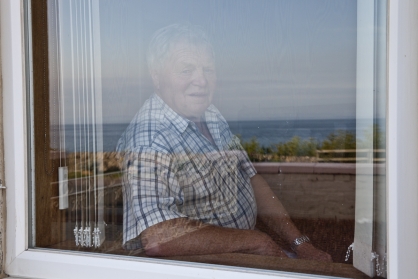
Robert McBain
Robert McBAIN looking at the Firth of Forth from his window in Pittenweem.
Son of a fisherman, he went to sea at 15 (the school leaving age of the time) in 1960, on his father’s boat, a seine netter. He became a skipper in 1968. In 1971 he got a 63 feet boat, the Sedulous, and fished for many years the Dogger Bank as fish got scarcer inshore and landed the catch in North Shields in England. In 1975, he bought a 70 feet boat and still fished the Dogger Bank until the early 80’s when the fish got scarce in that area. From 1985 to 2002 he landed mainly in Aberdeen as he was fishing further North half way between the Shetland Islands and Norway. He retired from North Sea fishing in 2001.
Home detail: painting of his fishing boat, the Sedulous, by John Shearer DA, in his living room.
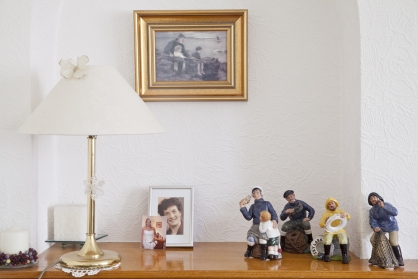
Harry Cuthbert living-room, July 2013.
Harry CUTHBERT at home in Anstruther.
He was first a baker in the merchant navy, then he became a fisherman (hold man) in the 1950’s because the fishing industry was more lucrative. He first worked on the Hope, a small fishing boat from Pittenweem owned by Thomas Anderson. He then worked on Ian Murray’s boats, the St Andrew at first and then, in 1973, he worked on the Ocean Triumph based in Aberdeen. Before retiring in 1984, he worked during a few years on Tom Gourlay’s boat, the Ardgour.
Home detail: painting of a fisherman with a child, photograhs of his wife and daughter.
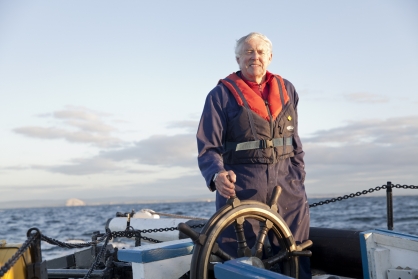
Ian Murray at the wheel of the Reaper in the Firth of Forth, Scotland, in July 2013.
Ian MURRAY, at the wheel of the Reaper, 1901 Fifer herring drifter that belongs to Anstruther Fisheries Museum.
Son of a fisherman, born in Cellardyke, he became a fisherman when he was 22 and only went to the fishing for the money. Fished on his dad’s boat before buying his own boat, the St Andrew, and was based in Pittenweem from 1968 to 1973, mostly seine netting for white fish. He then had 2 bigger boats, the Ocean Triumph I followed by the Ocean Triumph II (76 feet) built in 1977 and went fishing in the North Sea. He decided to sell his last boat in 1988 while boat prices were still good. He then became a fishing policeman on the West Coast of Scotland, and, soon after, a fish merchant in England. He is currently the skipper of the Reaper.
Home detail: model of his father’s steam herring drifter built in 1920 and photograph of the Reaper in his office.
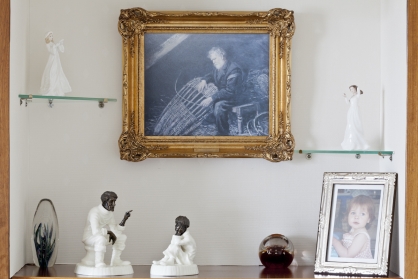
Jackie Taylor's living room, detail, July 2013.
Jackie TAYLOR at home in Pittenweem.
Started fishing aged 15 until he retired when he was 60 years old. He started like every other young fisherman at the time: as a cook. He then started seine netting on the Larachmhor, the biggest boat in Pittenweem at the time (60 feet long). Later he went line fishing at the Faroe Islands on the Brigther Hope, running 12 miles of lines every day (3500 hooks) until that fishing dried out. Then from 1968, he sailed with David Smith on the Argonaut for 25 years.
Home detail: reproduction by John McGhie, figurines of the traveler’s tales and spell bound, and portrait of his grand-daughter.
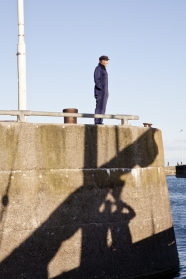
Coull Deas looks at the Reaper leaving the harbour in July 2013 in Anstruther.
Coull DEAS looking at the Reaper leaving Anstruther harbour. (The Reaper arrived in Anstruther in 1974, and Robert Prescott organized its restoration.)
Son and grandson of a fisherman, he was born in Anstruther in 1925. He became a cook boy at 13 on a herring boat. He then went to fish on bigger boats in the North Sea. He had his own fishing boat (40 feet) in the last 25 years and mainly caught prawns, lobsters and crabs in the Firth of Forth. He retired in 1990. Member of the boat’s club, he has been involved with the Fisheries Museum repairing and maintaining the boats. Coull has been the Reaper skipper for some years and he is currently the White Wing skipper (a smaller version of the Reaper). Both boats are based in Anstruther.
Home detail: Coull Deas received a MBE for 20 years of service to the Scottish Fisheries Museum in 2009.
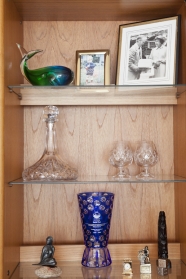
David Tod's living room, detail of a shelf in Cellardyke in July 2013.
David TOD next to the anchor he brought to the Fisheries museum in Anstruther.
Originally from a baker family from his father’s side and a fishing family from his mother’s side. He trained to be a marine engineer but was fishing locally from a young age. On a holiday trip to England in 1966, he bought a 36 feet boat that had its wheelhouse forward and thought it would be more suited for fishing in Scotland where boats had their wheelhouse aft; it was the start of stern trawling so there were more space to work at the stern. He then built a steel boat in 1969, the first in the country built with a net drum, an innovative method of handling the gears. He mainly fished for prawns in the Firth of Forth but he also spent some time fishing in deep waters on the West Coast. He retired some 20 years ago but still has boats, such as the St Adrian, in Pittenweem harbour. He is the vice chairman of the Fisheries Museum and started the museum’s boat club 39 years ago to operate the Reaper.
Home detail: picture of David Tod handing a box of prawns to the Queen and an award from the FMA for 37 years of service.
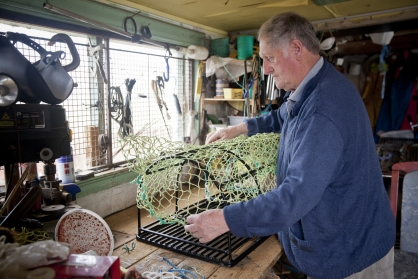
Billy Scott makes a creel in his garage in St Monans in July 2013.
Billy SCOTT making a creel in St Monans.
He became a fisherman when he was 16 in 1953. He first went line fishing on a boat from Anstruther, then on a local boat at 18 catching herrings, and then bought a share in a boat called the Floresco and went fishing in the North Sea, between Aberdeen and Holland. He had 3 boats between 50 and 60 feet over the years, all called Orion and all built in Arbroath.
When he was 63, he stopped fishing on big boats; he bought a smaller boat instead, the Fiona S, and went for the lobsters. His son, Richard, is now fishing on that boat in Pittenweem. Billy, now retired, makes and repairs creels for his son.
Home detail: photographs and painting of his fishing boats and his grandsons in his living- room.
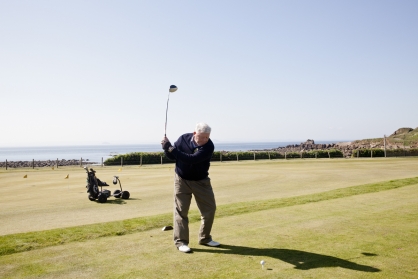
David Smith on Anstruther golf course in July 2013.
David SMITH practicing his swing on Anstruther golf course.
Son and grandson of a fisherman, he was born in St Monans. He became a fisherman (boy cook) in 1945 aged 15 on a herring drifter in the North East of Scotland. Later on, he became a deck hand on a steam trawler near Edinburgh. He got his mate’s ticket (second in command) when he was 20 and he became a skipper at 22. From 1954 until he retired in 1992, he was the skipper of his own boat the Argonaut and its successors. The Argonaut caught between 25 and 30 tonnes of fish every week on average in the North Sea. In 1974, it was the first Scottish boat to gross £200,000 for a year fishing.
David Smith has recently published his memoires in a book entitled: ‘Argonaut, Memories of an East Neuk skipper’.
Home detail: the Gold Haddock award presented to the skipper with the highest annual catch from 1966 to 1968.